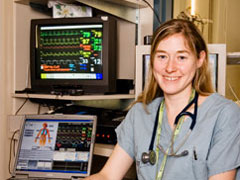Faking It
By Laura Pratt
The patient is unwell. He is suffering laryngospasm (condition where you cannot catch your breath), a pneumothorax (collapsed lung) and all the signs of an approaching heart attack. He has crackly breath sounds, brittle teeth and is almost certainly constipated. That he is, in fact, not even alive at all is the least of his concerns. Indeed, his “simulated” status is a bonus, given the role this 70-lb., 5’ 8” fellow plays in medical education, serving as a stand-in for the real thing while residents play out medical crises around him.
“Having access to this kind of training,” says Dominique Piquette, an intensive care unit fellow at Sunnybrook who is doing her masters in education at the Ontario Institute for Studies in Education, “is critical to effective, comprehensive medical education. Without this opportunity to practise real-life clinical emergencies on critically-ill patients in a safe setting, students are often as prepared as they might be for real situations.”
Piquette explains that residents invest just a couple of months in a critical care rotation, and are often passed over in favour of more senior fellows when volatile patients come in needing attention. It seems logical to look toward simulation to see how this tool could help those teaching and learning in such delicate conditions.
Enter Sim Man, a $60,000 high-fidelity mannequin simulator whose bodily functions mirror remarkably those of a human. Sim Man, who can “speak,” courtesy of an embedded transmitter hooked up to a control room microphone, has articulating joints, and femoral radial, brachial and corotid pulses. He has interchangeable sexual parts (and can be catheterized in either case), the ability to provide a manual blood pressure reading on the left arm, and to receive an intravenous insertion on the right. Blood flows from him, breathing takes place spontaneously and a saturation probe produces a wave form that measures oxygen saturation. He can be defibrillated, cardioverted and paced. He has anatomically correct airwaves, interchangeable teeth and a tongue that can swell.
Simulation has been a teaching tool for more than a decade, and its relevance has been increasingly acknowledged among medical educators with the explosion of simulation centres across the country. “Just the same,” says Piquette, “there has yet to be even one reliable study that demonstrates its efficacy. We know that the medical students like it, but there’s no clear study showing that this is really helpful in terms of patient safety or quality of care.”
Piquette aims to change that. Under the auspices of mentors such as Dr. Jordan Tarshis, an anesthesiologist and simulation researcher at Sunnybrook, and Dr. Rob Fowler, an associate scientist in clinical epidemiology at Sunnybrook Research Institute and critical care physician, she is first examining the role different stressors play on a doctor’s functioning when the pressure is on. For reference she’s turning to the worlds of aviation and military—who are celebrated for their emergency preparedness training. Ultimately, Piquette is keen to design a training program with an eye on a range of variables, including memory and attention, that proves, first, that it’s possible to induce a realistic situation in the simulation centre (featuring real-life examples like pagers going off, and the presence of a frantic family member), and, next, that a resident’s improved clinical performance in response to feedback from the experience is a natural extension.
“Preparing the medical team that responds to life-threatening patient events before they happen is key to ensuring optimal performance in stressful situations,” says Fowler. “Medical educators like Dominique who are using simulation are bringing procedural, crisis and interpersonal skills training to nurses, physicians and the health care team before they are needed, so they'll be as close to ready as possible when the arrest team pagers go off.”
The initial stages of Piquette's research project will be funded by a Peters-Boyd Academy Educational Grant.
PDF / View full media release »





